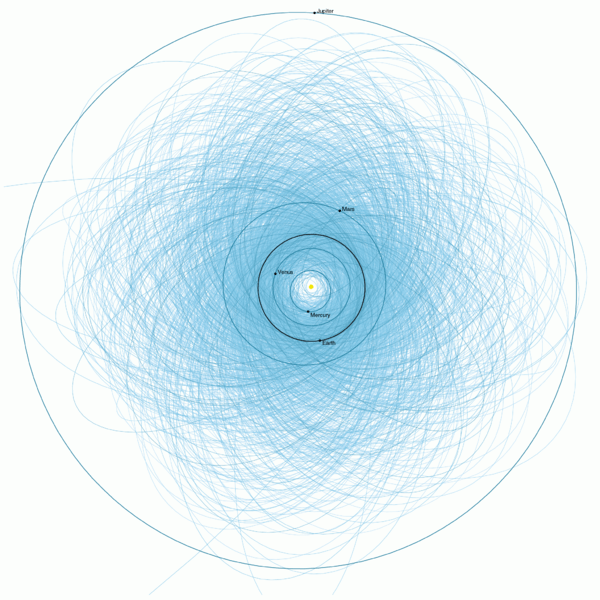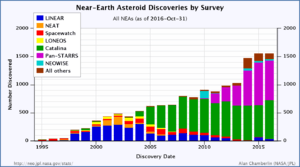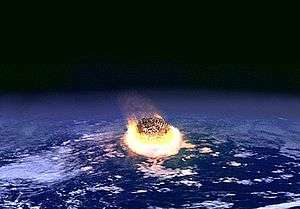Potentially hazardous object

A potentially hazardous object (PHO) is a near-Earth asteroid or comet with an orbit such that it has the potential to make close approaches to the Earth and is of a size large enough to cause significant regional damage in the event of impact. A potentially hazardous object can be known not to be a threat to Earth for the next 100 years or more, if its orbit is reasonably well determined and keeps it away from Earth. Potentially hazardous asteroids with a threat of impacting Earth in the next 100 years are listed on the Sentry Risk Table.
As of January 2016 there are 1,651 known potentially hazardous asteroids (PHAs)[1][2] and only 205 have an observation arc shorter than 30 days. Of the 1,651 known PHAs, 153 are believed to be larger than one kilometer in diameter.[3] A calculated diameter is only a rough estimate, as it is inferred from the object's varying brightness—observed and measured at various times—and the assumed, yet unknown reflectivity of its surface (albedo).[3] Most of the discovered PHAs are Apollo asteroids (1,402)[4] and fewer belong to the group of Aten asteroids (149).[5]
After several astronomical surveys motivated by their search, the number of known PHAs has increased tenfold since the end of the 1990s (see bar charts below). These surveys have led to a total number of 12,933 discovered near-Earth Objects. Most of them are asteroids, with just some 85 near-Earth comets (NECs).[3] The Minor Planet Center's website Unusual Minor Planets also publishes detailed statistics for these objects.[2]
In May 2016, the asteroid size estimates arising from the Wide-field Infrared Survey Explorer and NEOWISE missions have been questioned,[6][7][8] but the criticism has yet to undergo peer review.[9]
Overview

An object is considered a PHO[10] if its minimum orbit intersection distance (MOID) with respect to Earth is less than 0.05 AU (7,500,000 km; 4,600,000 mi)—approximately 19.5 lunar distances—and its diameter is at least 100 to 150 meters (330 to 490 ft)—corresponding to absolute magnitude H < 22. This is big enough to cause regional devastation to human settlements unprecedented in human history in the case of a land impact, or a major tsunami in the case of an ocean impact. Such impact events occur on average around once per 10,000 years. NEOWISE data estimates that there are 4,700 ± 1,500 potentially hazardous asteroids with a diameter greater than 100 meters.[11] As of 2012, an estimated 20 to 30 percent of these objects have been found.[11] Asteroids larger than 35 meters across can pose a threat to a town or city.[12]

|
LINEAR NEAT Spacewatch LONEOS |
CSS Pan-STARRS NEOWISE All others |
The diameter of most small asteroids is not directly measured and can only be estimated based on their brightness and distance. For this reason NASA and the Jet Propulsion Laboratory use the more practical measure of absolute magnitude (H). Any asteroid with an absolute magnitude of 22.0 or brighter is assumed to be of the required size,[1][13] although only a coarse estimation of size can be found from the object's magnitude because an assumption must be made for its albedo which is also not usually known for certain. The NASA near-Earth object program uses an assumed albedo of 0.13 for this purpose.[1]
Several astronomical survey projects such as Lincoln Near-Earth Asteroid Research and Catalina Sky Survey continue to search for more PHOs. Each one found is studied by various means, including optical, radar, and infrared to determine its characteristics, such as size, composition, rotation state, and to more accurately determine its orbit. Both professional and amateur astronomers participate in such monitoring.
During an asteroid's close approaches to planets or moons it will be subject to gravitational perturbation, modifying its orbit, and potentially changing a previously non-threatening asteroid into a PHA or vice versa. This is a reflection of the dynamic character of the Solar System.
The two main scales used to categorize the impact hazards of asteroids are the Palermo Technical Impact Hazard Scale and the Torino Scale.
The lowest numbered PHA is 1566 Icarus.[14] Short-period comets currently with an Earth-MOID less than 0.05AU include: 109P/Swift-Tuttle, 55P/Tempel–Tuttle, 15P/Finlay, 289P/Blanpain, 255P/Levy, 206P/Barnard–Boattini, 21P/Giacobini–Zinner, and 73P/Schwassmann–Wachmann.
Largest PHA
The largest known Potentially hazardous asteroid is (53319) 1999 JM8 with a diameter of ~7 km, but it is not currently at risk of any impacts. Below is listed the largest PHA (based on absolute magnitude H) discovered in a given year.[15] Historical data of the cumulative number of discovered PHA since 1999 are displayed in the bar charts—one for the total number and the other for objects larger than one kilometer.[3]
| Number | Name | Year | (H) |
|---|---|---|---|
| 4179 | Toutatis | 1989 | 15.3 |
| 4953 | 1990 MU | 1990 | 14.1 |
| 7341 | 1991 VK | 1991 | 16.7 |
| 5604 | 1992 FE | 1992 | 16.4 |
| 39572 | 1993 DQ1 | 1993 | 16.4 |
| 136618 | 1994 CN2 | 1994 | 16.6 |
| 243566 | 1995 SA | 1995 | 17.3 |
| 8566 | 1996 EN | 1996 | 16.5 |
| 35396 | 1997 XF11 | 1997 | 16.9 |
| 16960 | 1998 QS52 | 1998 | 14.3 |
| 137427 | 1999 TF211 | 1999 | 15.0 |
| 23187 | 2000 PN9 | 2000 | 16.1 |
| 111253 | 2001 XU10 | 2001 | 14.9 |
| 89830 | 2002 CE | 2002 | 14.7 |
| 242216 | 2003 RN10 | 2003 | 15.7 |
| 242450 | 2004 QY2 | 2004 | 14.7 |
| 308242 | 2005 GO21 | 2005 | 16.4 |
| 374851 | 2006 VV2 | 2006 | 16.8 |
| 214869 | 2007 PA8 | 2007 | 16.2 |
| 294739 | 2008 CM | 2008 | 17.15 |
| 369264 | 2009 MS | 2009 | 16.0 |
| 381906 | 2010 CL19 | 2010 | 17.55 |
| 415029 | 2011 UL21 | 2011 | 15.7 |
| – | 2012 LK9 | 2012 | 17.8 |
| – | 2013 UP8 | 2013 | 16.5 |
| – | 2014 LJ21 | 2014 | 16.0 |
| – | 2015 HY116 | 2015 | 17.5 |
Gallery
 The 360-meter PHA (308635) 2005 YU55
The 360-meter PHA (308635) 2005 YU55
See also
- Asteroid impact avoidance
- Earth-grazing fireball
- Global catastrophic risk
- List of asteroid close approaches to Earth
- Spaceguard
References
- 1 2 3 "Potentially Hazard Asteroids". Retrieved 2011-08-06.
- 1 2 "Unusual Minor Planets". Minor Planet Center. Retrieved 2012-05-17.
- 1 2 3 4 5 6 7 "Near-Earth Asteroid Discovery Statistics". Retrieved 2015-08-09.
- ↑ "JPL Small-Body Database Search Engine: PHAs and orbital class (APO)". JPL Solar System Dynamics. Retrieved 2014-02-23.
- ↑ "JPL Small-Body Database Search Engine: PHAs and orbital class (ATE)". JPL Solar System Dynamics. Retrieved 2014-02-23.
- ↑ Chang, Kenneth (23 May 2016). "How Big Are Those Killer Asteroids? A Critic Says NASA Doesn't Know.". New York Times. Retrieved 24 May 2016.
- ↑ Myhrvold, Nathan (23 May 2016). "Asteroid thermal modeling in the presence of reflected sunlight with an application to WISE/NEOWISE observational data". arXiv:1605.06490v2
 .
. - ↑ Billings, Lee (27 May 2016). "For Asteroid-Hunting Astronomers, Nathan Myhrvold Says the Sky Is Falling". Scientific American. Retrieved 28 May 2016.
- ↑ NASA Administrator (25 May 2016). "NASA Response to Recent Paper on NEOWISE Asteroid Size Results". NASA. Retrieved 29 May 2016.
- ↑ Task Force on potentially hazardous Near Earth Objects (September 2000). "Report of the Task Force on potentially hazardous Near Earth Objects" (PDF). Retrieved 2010-06-28.
- 1 2 "NASA Survey Counts Potentially Hazardous Asteroids". NASA/JPL. May 16, 2012. Retrieved 2012-05-17.
- ↑ Will Ferguson (January 22, 2013). "Asteroid Hunter Gives an Update on the Threat of Near-Earth Objects". Scientific American. Retrieved 2013-01-23.
- ↑ "Conversion of Absolute Magnitude to Diameter". Minor Planet Center. Retrieved 2009-05-13.
- ↑ List of Potentially Hazardous Asteroids
- ↑ "JPL Small-Body Database Search Engine: PHAs and H < 18 (mag)". JPL Solar System Dynamics. Retrieved 2012-06-13.
External links
- Sentry Risk Table (current) (NASA NEO Program)
- Very Close Approaches (<0.01 AU) of PHAs to Earth 1800-2200
- TECA Table of Asteroids Next Closest Approaches to the Earth (Sormano Astronomical Observatory)
- MBPL - Minor Body Priority List (PHA Asteroids) (Sormano Astronomical Observatory)
- Responding to the Threat of Potentially-Hazardous Near Earth Objects (PDF)
- Risk of comet hitting Earth is greater than previously thought, say researchers, The Guardian, 22 December 2015.
Minor Planet Center
- List of the Potentially Hazardous Asteroids (PHAs)
- Asteroid Hazards, Part 2: The Challenge of Detection on YouTube (min. 7:14)
- Asteroid Hazards, Part 3: Finding the Path on YouTube (min. 5:38)


